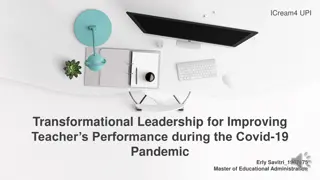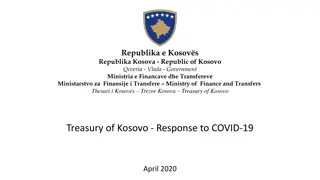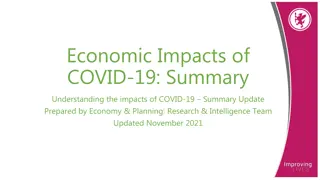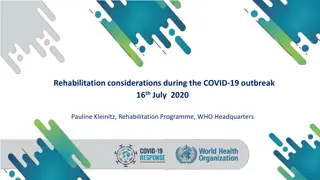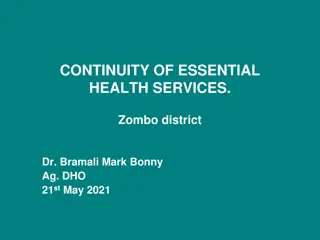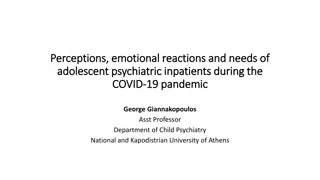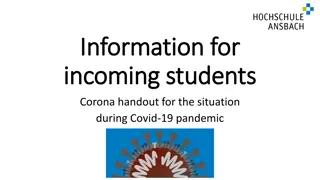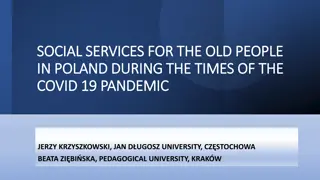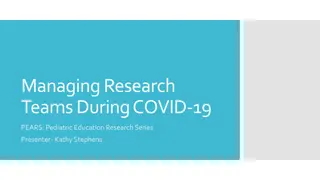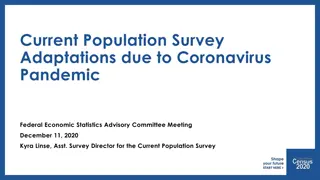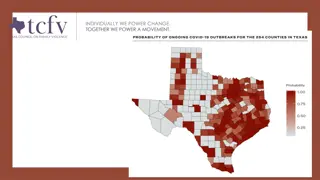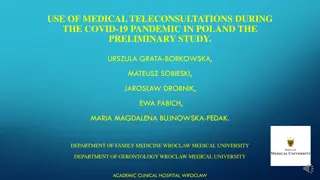Support Strategies for Schools During the COVID-19 Pandemic
In response to the challenges brought by the COVID-19 pandemic, this guide offers support strategies for schools, emphasizing the importance of adapting teaching methods, providing targeted support, and implementing wider strategies to benefit all students, especially those disadvantaged. The guide outlines the role of great teaching, pupil assessment and feedback, and transition support in ensuring effective learning outcomes. It highlights the significance of clear scaffolding, cognitive strategies, flexible grouping, and effective diagnostic assessment in addressing learning needs, emphasizing that assessment is rooted in classroom practice.
Download Presentation

Please find below an Image/Link to download the presentation.
The content on the website is provided AS IS for your information and personal use only. It may not be sold, licensed, or shared on other websites without obtaining consent from the author. Download presentation by click this link. If you encounter any issues during the download, it is possible that the publisher has removed the file from their server.
E N D
Presentation Transcript
COVID-19 SUPPORT GUIDE FOR SCHOOLS
For educators, coronavirus has created the test of a generation. When pupils start the new school year in September, most will be returning to the classroom for the first time in almost six months. Thanks to the heroic efforts of teachers across the country, many children have been able to keep learning while staying at home. The resourcefulness and range of responsibilities taken on by teachers and school leaders during the pandemic has been inspiring. But there is no shame in acknowledging what teachers know best: children learn less when they are not in school. The consequences of the pandemic will be far reaching for all children, but particularly for those from socially disadvantaged families. There have been wide disparities in engagement. FOREWORD EEF chief executive
SUPPORT STRATEGIES IN RESPONSE TO COVID-19 PANDEMIC: Support will differ between schools Will benefit ALL pupils but especially DISADVANTAGED CHILDREN who are likely to have been affected particularly badly by school closures. It is highly unlikely that a single approach will be enough INTRODUCTION
1. TEACHING & WHOLE-SCHOOL STRATEGIES 2. TARGETED SUPPORT 3. WIDER STRATEGIES EEF DEFINES 3 STRATEGIES
A) Supporting great teaching: - CPD to support curriculum planning and teachers depth of curriculum knowledge (e.g. Ashley Booth / Chris Quigley resources) - Focussed training on the effective use of technology (e.g. Google Classroom) B) Pupil Assessment & Feedback - Assess pupils well-being and learning needs (RAG needs assessments and on-going) C) Transition Support 1. TEACHING & WHOLE-SCHOOL STRATEGIES
Explicit / Clear Scaffolding (e.g. task checklists to support pupils to independently complete tasks) Use of cognitive / metacognitive strategies (e.g. visual diagrams and knowledge organisers) Flexible grouping (differentiation) TEACHING Effective diagnostic assessment What learning has been lost/misunderstood? What knowledge and experiences have been gained? Should we reteach to whole group or move on? EFFECTIVE ASSESSMENT IS ROOTED IN CLASSROOM PRACTICE use of verbal questions, short answer quizzes, multiple choice questions Consider social and emotional outcomes too. ASSESSMENT
Teaching quality is more important than the way lessons are delivered i.e. ensuring the elements of effective teaching are present (clear explanations, scaffolding & feedback). Ensuring access to technology Peer interactions provide motivation and improve learning outcomes e.g. peer marking and feedback and sharing models of good work. Supporting pupils to work independently can improve learning outcomes. Explicit modelling of independent learning strategies & guided practice, e.g. prompting pupils to reflect on their work and strategies to use if they are stuck. Different approaches to remote learning suit different tasks and types of context consider which are the most effective to lesson content and age of pupils. VERBAL FEEDBACK IS ESPECIALLY IMPORTANT (good if it can be from peers too). It allows pupils to digest feedback and is also important to hear their teacher s voice. SUPPORTING REMOTE LEARNING These strategies should be integrated into school routines and homework in the year ahead.
A) One to One & Small Group Tuition - Most effective when delivered by qualified teachers. If tutors or TAs are used then training is needed (feedback/liaison time too). B) Intervention Programmes - (e.g. Reading, oral language) C) Extended School Time 2. TARGETED SUPPORT
HIGH QUALITY TEACHING should reduce the need for extra support, but some pupils will need high- quality, structured, targeted interventions to make progress. HIGH QUALITY TEACHING Where sessions are brief (15-45 mins) Regular (3-5 times per week) Maintained over a sustained period (8-20 weeks) Staff receive extensive training There are lesson plans with clear objectives and appropriate resources TAs / academic tutors follow the plan / structure Assessments identify pupils, guide areas for focus and track pupils progress Connections are made between out-of-class interventions and classroom teaching interventions are necessary, EEF research suggests
Be careful TAs could potentially widen gaps. Minimise the use of TAs to lead bubbles. Don t assign TAs to low prior attaining groups and do involve them in the planning for the class. Draw up an agreement for TA teacher interactions, which sets out complimentary roles in lessons e.g. TAs to focus on developing pupils independent learning skills. Adopt ONE/TWO well-chosen and well-implemented TA led interventions, judiciously used to complement and extend class-based teaching and learning. TAs & Targeted Support TAs should be deployed in a way that SUPPLEMENTS, NOT REPLACES, the teacher ENSURE CAREFUL SCAFFOLDING FOR SEND PUPILS SELF REGULATION, ORGANISING EQUIPMENT, TIME & REMEMBERING ROUTINES Teachers must be aware of pupils learning needs and have wider conversations with parents, colleagues, specialist professionals and the child in order to establish next steps. Consistent routines and a pro-active approach to behaviour are essential.
A) Supporting Parents & Carers - e.g. Communications, importance of attendance, social and emotional B) Access to technology C) Summer Support 3. WIDER STRATEGIES
Develop a plan. Audit communications with less involved families (what has worked well?) Personalise messages. Encouragement routines, study tips & celebrate successes. Focus on pupils self-regulation e.g. a quiet place to study, organisation of equipment, work routines, habits. MAINTAIN COMMUNICATION WITH PARENTS EYFS KS1: Promote shared activities reading together or playing with letters and numbers. Set short, focussed learning projects that parents can more easily manage. Encourage positive home learning environment books, puzzles, toys. KS2 & older: Parents encouragement for, and interest in, pupils studies are more important than direct involvement. Provide general information to parents in order to create a helpful context. Support parents with children of different ages
EEF GUIDE TO SUPPORTING SCHOOL PLANNING (2020-21) TIERED MODEL NAME OF SCHOOL HERE Woodborough CE Primary School Supporting Curriculum Planning: - Chris Quigley resources - Books to support Ashley Booth WCR units. - Resources to support Word Aware focus on oracy across the school Remote learning support: - Seesaw upgrades as necessary (per month, per class) - Doodle Maths & English Focussed training on the effective use of technology: - Google Classroom roll-out - I P-S s time Reading: - Additional TA for reading (11 hours / week) Supporting Parents & Carers: - Additional PSA & ELSA hours? - Bereavement CPD & support - Communications (e.g. medical tracker) Access to technology: - 30 x Chromebooks in Y4 (3 year lease) + storage/charging facility.


